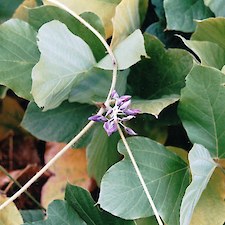 Kudzu vine
Kudzu vine
Common name: Kudzu vine
Botanical name: Pueraria montana var. lobate
Management category: Eradication
Where is it originally from?
Kudzu vine originates from Japan and is extremely fast growing – up to 30cm per day! During World War II, kudzu vine was introduced to several countries by United States Armed Forces to serve as camouflage for equipment. Here in NZ it became well established in Northland by the 1940’s.
Why is it a pest?
- Kudzu vine out-competes native plant species by smothering them with dense foliage, causing them to die underneath and therefore stop any chance of new native seedlings establishing.
- It is tolerant to a wide range of environmental conditions growing in both full sun and shade.
- It spreads by seed, stem fragments and rhizomes in a variety of methods (birds, waterways, machinery, garden waste dumping).
Where is it found?
Risk areas include roadsides, forest margins, and native bush, but can establish and grow in most environments.
There are four sites in the western Bay of Plenty. No other known sites for the region.
What does it look like?
- Kudzu is a high climbing, woody vine (10-30m high) with large tuberous roots.
- Large leaves 15-20cm long with three individual leaflets up to 7–10cm long and hairy undersides.
- Flowers are present in the summer months and seeds follow late summer / early autumn.
- Hanging clusters of pea-like, purple to red flowers with a grape-like fragrance and are followed by hard oval seeds in flattened, hairy, brown, bean-like pods.
- Tuberous, semi-woody, fibrous roots go to 3m deep, and grow in all directions and root at each node (the junction of leaf stalk and stem).
What are the rules?
Eradication
Kudzu vine is an eradication pest. This means that it is present in the region but in a limited size or extent of infestation.
Bay of Plenty Regional Council is responsible for Kudzu vine control in the region.
How do you get rid of it?
Please do not attempt to control Kudzu vine yourself. Contact council and a biosecurity officer will get in touch to get more information and arrange a site visit.
Images



